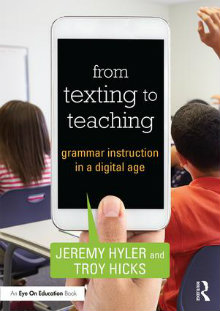Teaching Students Grammar in an Auto-Correct World
From Texting to Teaching: Grammar Instruction in a Digital Age
By Jeremy Hyler and Troy Hicks
(Routledge/Eye On Education, 2017 – Learn more)

Working grammar instruction, truly meaningful grammar instruction, into today’s curriculum seems to be an impossible feat. Educators face sometimes insurmountable obstacles of language barriers and students reluctant to learn spelling or grammar basics because technology “auto corrects” everything they write.
Many students do not have mastery over the very basics of grammar instruction because spelling and grammar are often not explicitly taught; instead, grammar and spelling are worked into other lessons and taught in context.

Jeremy Hyler and Troy Hicks have tackled these issues head on in From Texting to Teaching: Grammar Instruction in a Digital Age.
Convincing students to see the value in grammar is the biggest obstacle to instruction. They may counter our efforts with “Why does it matter how I say it if you can understand my meaning?”
The authors offer a meaningful response: Instruct students about their natural ability to “code switch,” which is covered in some detail in this useful text. By including students in the “why,” it becomes easier to convince them of the “how,” and students begin to buy into their education because they immediately see the value behind what they are being asked to learn.
Breaking through the boredom barrier
Hyler and Hicks begin their book by identifying ‘what’s the matter with teaching of grammar,’ and they (correctly) identify it as being boring to learn. To break through the interest barrier, teachers need to tackle the teaching of grammar as a necessity that can also be fun. With the implementation of Common Core, the focus shifted to finding deeper meaning in concepts, versus skills.
Students need to be able to critically evaluate their reading, but grammar has become an additional feature of a larger overall concept: language. There is no longer a focus on the individual skills needed to be proficient with written language, and students receive only a basic overview of concepts in favor of those which are more heavily tested.
Hyler wrote this book over the 2015-2016 school year, during which he focused on teaching meaningful grammar instruction and began the collaboration with Hicks which produced this book. The idea of the book is to highlight what worked and what did not, and to allow readers to choose what they wish to implement in their own classroom.
Adding technology to grammar learning
For Hyler to interest his students, he needed to identify how to engage them (technology), though he admits he does not use technology “just as a hook” (14). Each chapter is organized in a logical way to help ease the struggle as teachers work to implement something new into their curriculum. There are practical ideas for lessons to address the standards where students need the most help.
The most beneficial material to a technophobic teacher is found in Chapter 2, which addresses how to teach grammar with technology. Instead of simply creating worksheets online or very basic message boards for online use, there is a matrix on page 32 listing many of the free online tools available and how to access them. This list is most beneficial to those of us who are less familiar with best practices for implementing technology. Pages 34 and 35 offer an intermediate matrix, and page 35 includes a few ideas for the technology expert looking for more education-based tools.
From releasing gradually to flipping
Though this book is excellent for the novice technology user, there are also ideas which can be used by teachers of any proficiency. With education focusing on gradual release and the flipped classroom, there are sections in Chapter 3 which address each teaching concept and how to implement grammar instruction using these approaches. For the flipped classroom, there is a section on how to use video instruction for students to practice what they have learned. This gives them a chance to truly see themselves in practice and how their skill base has grown.
There is also a chapter dedicated to formal versus informal writing, and this section holds many of the ideas for practical implementation. The chapter on enlivening vocabulary (thankfully) has ideas other than simply playing games with the students.
Read Jeremy Hyler’s MiddleWeb article
“Teaching Students to Write for Real-Life Contexts”
Mechanics of grammar are also addressed, though this chapter is very slim when compared to the rest of the text. Obviously, this tome is not intended to be used for what to teach, but rather how to teach it more effectively, but one might expect this section to contain more than it does for effective instruction.
Overall, this is a very interesting and engaging book on how to motivate students to genuinely see the difference in what it is they are writing and why it matters to a larger audience. By implementing the ideas within this book, even the most hesitant teacher may become a technological marvel with students who are capable and willing to write like a pro!
Erin Corrigan-Smith is a middle school ELA teacher in a suburb of Atlanta. She has a B.A. and M.A. in English, and her focus of study is children’s literature. During the school year, she is faculty advisor to drama club. In her downtime, she enjoys going to her family’s cabin in the North Georgia mountains with her husband and dog to read and relax.


































